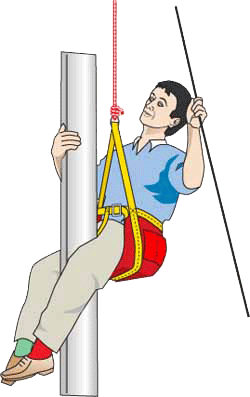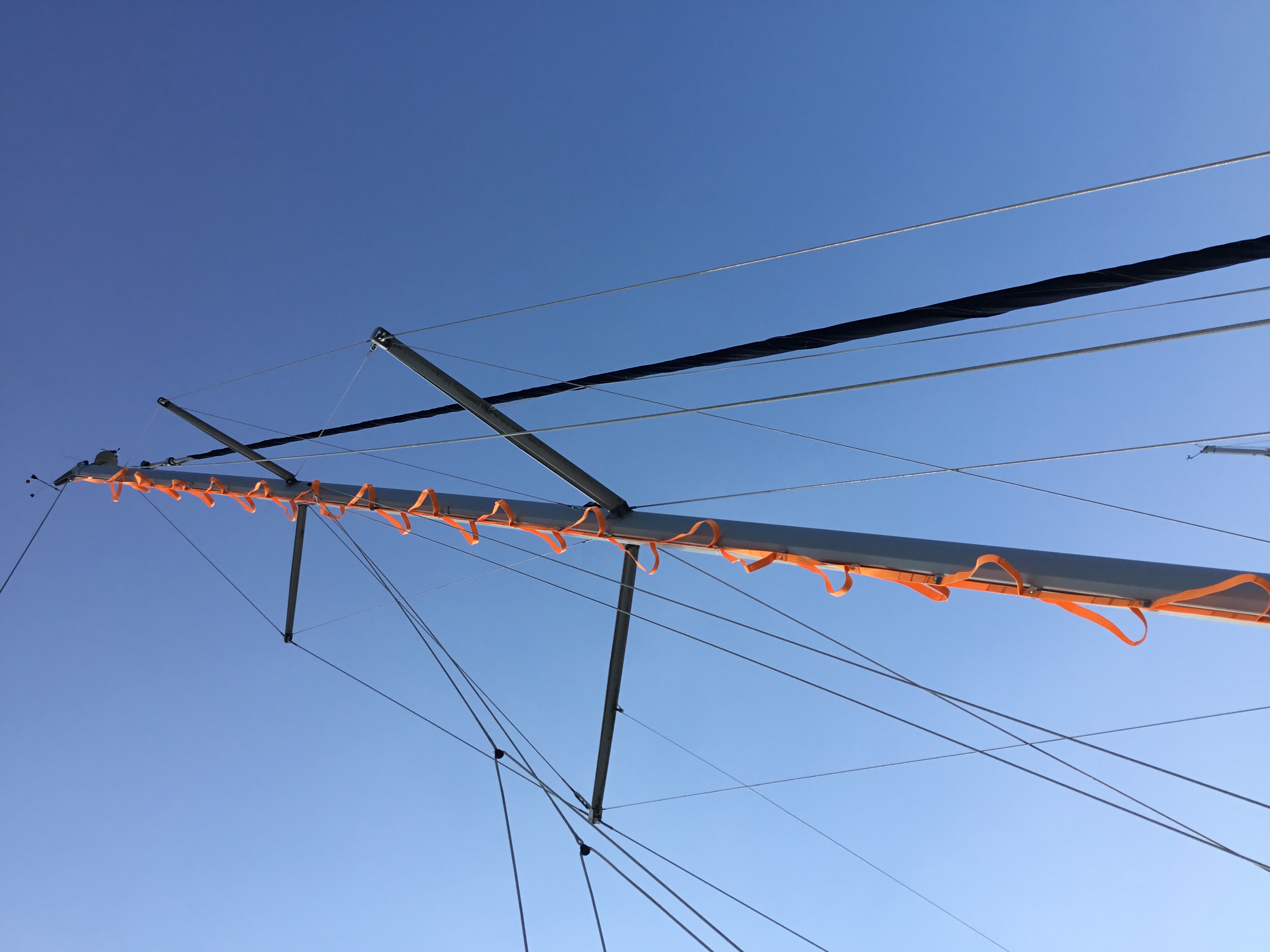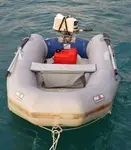- Home
- Choosing Accessories
- Bosuns Chair
The Bosuns Chair and
Other Means of Going Aloft
OK. I'll admit it; the prospect of going aloft in a bosuns chair, or any other mast climbing device, is for me no longer a joyful one. Not that I've ever fallen off, it's just that I always feel as though I might. Perhaps I'm getting old...
 Not another trip up the mast...
Not another trip up the mast...But go aloft we must from time to time.
There's so much stuff up there that can demand our attention - the tricolour and anchor light, the VHF antenna, the wind indicator, the anemometer, the spinnaker halyard block all reside at the masthead.
Lower down we have the radar reflector, the steaming light and the deck light, the small blocks for the flag halyards...
Yes, there's no avoiding it - we all need a bosuns chair or some similar device.
But not only must it be safe, it must feel safe if it's to inspire confidence in the user.
The Traditional Bosuns Chair
The most basic type is little more than a short plank, supported by a pair of rope bridles.
This type is highly regarded by some old salts as the most practical of all. And well it may be, but with little to stop you sliding off it, it's not the safest of designs.
Canvas Types
Canvas models, which you sit in rather than on, offer much more security and generally come equipped with side pockets and clips for tools and equipment.
For those that prefer a rigid seat, some canvas models are designed with the option of inserting a wooden one.
These are fine if you're being hauled up on a halyard, but not so good if you're climbing up on mast-steps. The problem is, as soon as you use you legs to climb, you're no longer in the sitting position - and you're out of the chair.
Mast Climbing Harnesses
If, rather than relying entirely on your winchman, you prefer to take an active part in clambering aloft, then one of the new generation mast climbing harnesses are an improvement on the conventional bosuns chair.
These types, which incorporate a waist strap and leg straps, allow you full use of your arms and legs whilst removing any chance of tipping out, and are ideal for going aloft with mast steps.
Mast Steps
If your cruising takes you to the tropics, it's handy to have mast-steps up to the first set of spreaders from where, with the sun over your shoulder, you can spot the coral reefs.
And it's always useful to have a couple at the top of the mast for support when you're working up there, so it doesn't take a great leap of imagination to fit them in the intervening mast section.
Fixed Mast Steps, convenient in as much as you don't have to open them on the way up or close them on the way down, create additional windage and are prone to hooking up sheets and halyards when you'd rather they didn't. In high winds they can be noisy.
My preference is for the folding type.
Mast Ladders
Conventional rope ladders with wooden rungs have been largely replaced by much lighter versions fabricated from webbing strap with carbon fibre rung inserts. They're deployed on a halyard hoisted to the masthead and secured at the foot of the mast. Even so they must be strapped to the mast at a couple of points to stop them swinging about.
Another design incorporates foot loops and is hoisted up the mainsail track. The loop should be reinforced to reduce the pinching force on your feet - you'll find deck shoes will help too.
 A Mast Ladder
A Mast LadderBefore buying one of these, you should check that it will fit your track or mast groove.
It used to be that if you've got an in-mast furling mainsail, then this type of ladder wasn't for you. Similarly, if your reason for going up the mast was to investigate a mainsail that refused to come down there wasn't much point in getting the ladder out of its bag, unless you've got a separate mast track.
However, most of the in-mast furling systems produced today incorporate an integral spare luff groove which resolves these issues.
Rope Climbing Gear
Rock climbers and mountaineers have been using this type of equipment for years, although the purists amongst them may tell you it's cheating. At the centre of this system is the jumar - a one-way, hand-operated rope jammer - or in the case of the 'TopClimber', two of them.
This device consists of two parts - a bosun's chair with a backrest and a jumar, together with webbing foot loops and a second jumar. The whole shebang is set up on a taut halyard attached to the deck.
With one of these you can shin up the mast like a monkey up a stick, by alternatively standing up on the leg straps, then sliding the bosuns chair jumar up the rope, then sitting into the bosuns chair, which allows you to slide up the foot loop jumar, then standing up on the foot loops.
Repeat the process until you find yourself at the masthead, and reverse the procedure to get back down.
Recent Articles
-
Optimising Your 12-Volt Boat Fridge for Offshore Sailing & Efficiency
Dec 01, 25 11:05 AM
Master your 12-Volt Boat Fridge system. A guide for experienced sailors covering mechanics, installation, troubleshooting, and advanced electrical efficiency on extended voyages. -
Jonmeri 40: Cruising Specs, Performance Ratios & Review
Nov 30, 25 09:08 AM
An in-depth, expert review of the Jonmeri 40 sailboat. Analyse design philosophy, D/L & CSF ratios, cruising suitability, and common ownership concerns for this Finnish-built, high-performance ocean c… -
Alajuela 48: Review, Specs, & Performance Ratios for Offshore Cruisers
Nov 29, 25 12:46 PM
Detailed analysis of the Alajuela 48 full-keel cruiser, including designer Robert Perry's philosophy, comprehensive specifications, key design ratios (SA/D, D/L, CSF), and suitability for experienced…
















